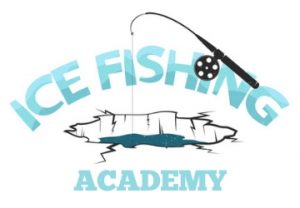Why do you see others catching and landing fish nearby while you’re not getting any hits on your line? The secret may be how they’re jigging their jigs and spoons! Here’s a great overall technique to use when you want to catch more fish!
To properly jig when ice fishing, drop your jig straight to the bottom of the lake. Pound it on the bottom to imitate feeding minnows. Raise it a few inches and twitch it. Hit bottom again and raise and twitch it. Then jig it every few feet up through the water column. Repeat and move to the next hole.
Jigging spoons and baits are the most productive way to catch fish when ice fishing. But numerous variables will enhance your jigging success, and we will review them below for you!
How to Jig When Ice Fishing
Whether you’re jigging on a new lake or an old favorite spot, you’ll want to give it 100% and fish the entire water column! I’ll show below how to jig your ice fishing hole properly, why it’s a killer technique, and why it works so well!
1. Drop Your Jigging Spoon Straight to the bottom
Open the reel bail and drop your lure straight to the bottom of the lake. Since most fish species congregate at or near the bottom, you want to get your spoon down to them immediately!
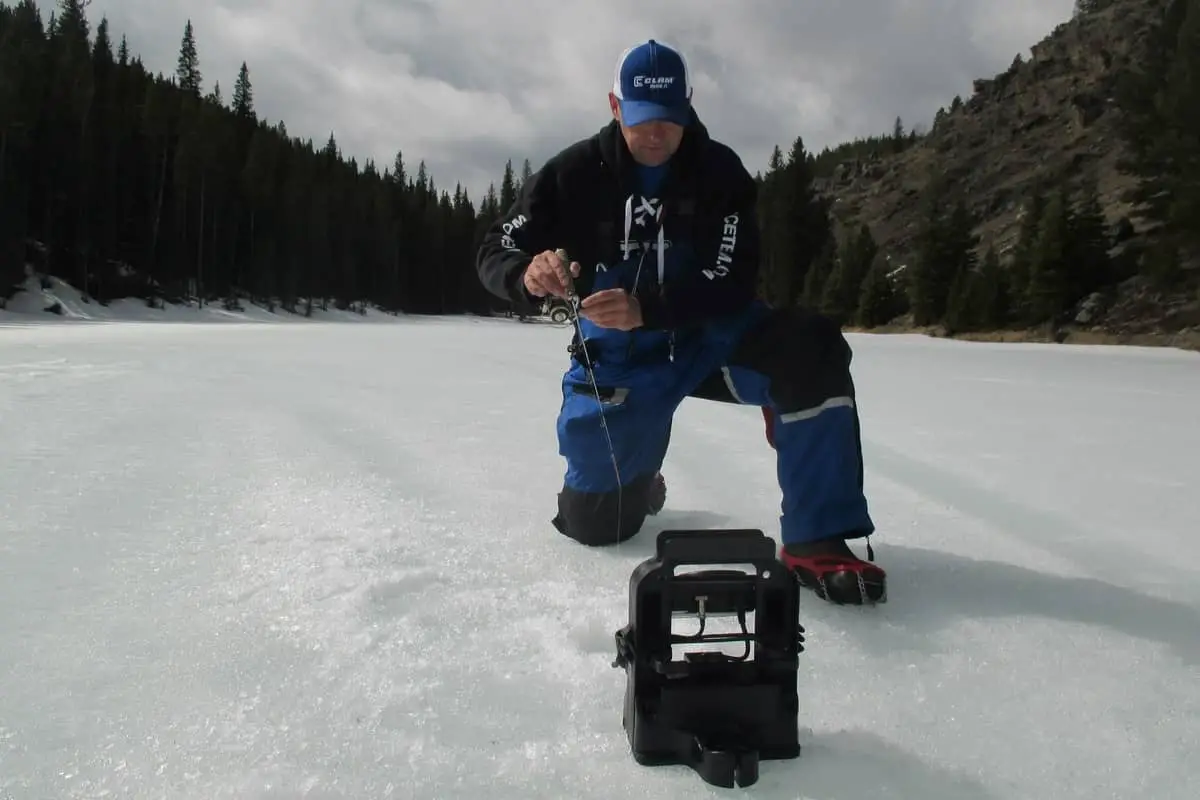
The flash and flutter, or action of your soft plastic baits as the jig falls, will attract nearby fish. Aggressive feeding fish will often hit your spoon on its way down or right as it hits the bottom!
2. Pound the Bottom of the Lake To Raise Sediment
Close your reel bail and pound (raise your lure a few inches and drop it back quickly a few times) the bottom to raise the sediment and imitate a feeding minnow.
Pounding the lake’s bottom, you will attract fish from a short distance away. Fish feel the vibrations through the lateral lines on the sides of their bodies and will come to investigate the commotion!
Pounding the bottom can get aggressive fish to strike your spoon!
3. Raise the Spoon a Few Inches and Begin Jigging
Raise and hold the lure a few inches from the bottom and jiggle or twitch it a few times. Once a fish notices your spoon pounding the bottom, it may come over to see what it is!
When you raise it a few inches, it allows the fish to see it, and by twitching the jig, it may instinctively inhale it as a food source!
4. Pause for 5 to 10 Seconds and Jig Again
Let the lure pause for 5-10 seconds and then jiggle or twitch it again. This movement and pause sequence keeps the fish interested in your bait.
We do this because an aggressive fish will hit your moving spoon or jig, and a passive fish will wait until it stops. By jigging and pausing, you allow the fish to strike either way!
5. Repeat This Jig and Pausing 4 to 5 Times
Repeat this twitch/pause/twitch four to five times. When you repeat the sequence and repeat it in varying numbers, other fish will often gather around and can start to feed competitively.
One fish that may not be as interested will swoop around another fish to get to the food source first! So keep the jigging and pausing going!
6. Drop Back to the Bottom and Pound the Spoon Again
If you’re not getting any action, drop the spoon back to the bottom and pound the bottom again. Pounding your spoon and raising a larger sediment cloud means minnows or something else is feeding off the bottom.
Fish swimming nearby are attracted to this action, so you’ll want to repeat it a few times.
7. Raise a Few Inches and Repeat the Twitch Sequence
After letting your spoon or jig stir up the bottom, you want to raise it a few inches so feeding fish will see it. It may take a few times of jigging in this manner to entice a fish to strike!
Suppose you feel a light bite or tap and didn’t get a hook set, jig with a slightly reduced jigging movement, or s-l-o-w-l-y raise and lower the jig slightly! This technique may get them to come in harder!
8. Reel Your Jig up a Few Feet and Jig
After fishing the bottom for a few minutes and not getting any action, crank your reel up a few turns raising the lure a couple of feet, and repeat the twitch sequence two to three times.
This may be a day when fish aren’t holding tight to the bottom structure! Not a problem! Let’s raise or spoon up a few feet and try the same jigging sequence!
Keep in mind, on certain days, fish may want a slower or quicker jigging cadence than others. So experiment with your jigging!
9. Repeat Jigging Through the Entire Water Column
Repeat the twitch jigging sequence by reeling up a few turns while fishing the entire water column (fish may be holding higher off the bottom).
You’ll often see fish suspended over deeper waters too! Crappies, for example, will suspend in the middle of the water column in fairly deep water!
In the photo below, there aren’t any fish near the bottom. They are “suspended” between the 20′ and 30′ marks! This is why you want to fish the entire water column!
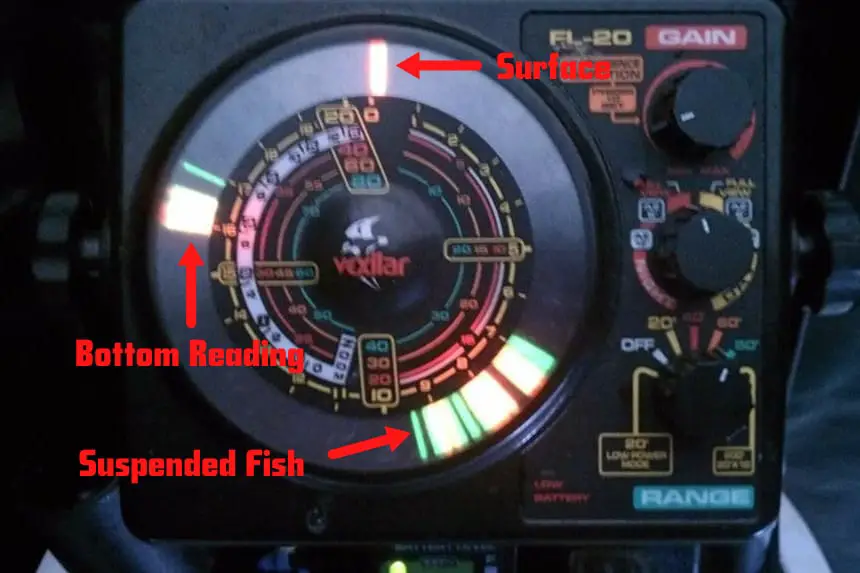
Fishing the entire water column is essential to your success without a flasher! Having a flasher like the one above lets you see where the fish hang out. Either on the bottom or suspended somewhere in the water column.
Even if you have a flasher, fish may be holding off to the side of the sonar cone. You’ll still want to fish the entire water column because you can catch fish off your sonar to the side of the hole!
10. When Close to the Ice, Drop Jig to the Bottom
Once you are a few feet beneath the ice, allow the lure to free fall again to the bottom, raise the sediment, and repeat the sequences.
11. Jig the Column Twice, Then Move to Your Next Hole
As a general rule, I will repeat the above jigging sequence twice to fish that hole thoroughly. We are looking for actively feeding fish, and they are feeding somewhere!
If you feel there are fish below, maybe you’ve had success before; change your jig color and give it another go! After fishing the water column twice, I move to the next hole and begin the process again!
Difference Between Ice Fishing Jigs and Spoons
What are Spoons?
Spoons are vertical lures, some with rattle chambers, and can be differentiated most often by a split ring between the lure and the hook. The split ring allows the bait to articulate and gives it flash and flutter when your raise and drop it.
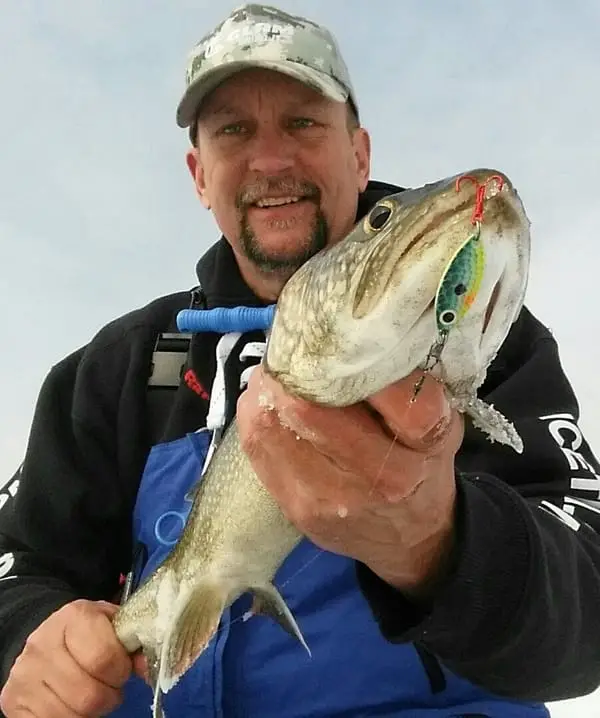
Pro Tip: Lake Trout can be anywhere in the water column. When you mark one on your fish finder, reel away from them quickly, and they will aggressively chase your bait down as you reel up!
The spoon has a treble hook, although you will see a single shank hook on some spoons. Ice anglers will often change the treble hooks for red hooks to resemble a bleeding fish or a single hook for a smaller presentation to the fish.
What are Jigs?
Jigs are fixed hooks with a lead head; nowadays, you’ll find them with a tungsten head that is fished with a horizontal presentation.
Jigs will come with a plastic body, or you can also purchase them with a bare exposed hook. Anglers will tip these jigs with soft plastics or live bait.
Soft Plastics are Taking Over the Live Bait Anglers
A good friend and skilled angler, Scott Brauer, has developed a line of high-quality soft plastic baits that have retired my minnow bucket and live bait needs!
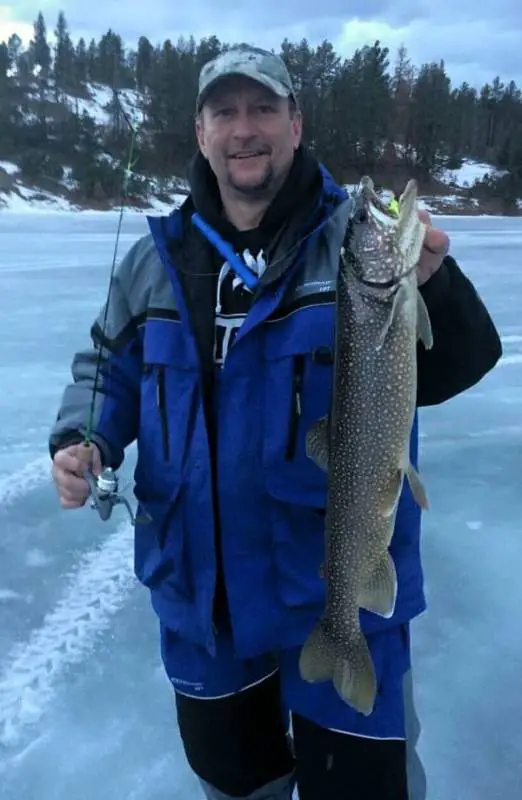
One of my favorite soft plastic baits is the Maki from Makiplastic, which I carry 100% of the time. When moving from spot to spot, I don’t want to be hindered by bait buckets and splashing water!
A handful of these specialized plastics in my pocket will keep me on fish all day long! In the video below, Scott Brauer shows a killer technique to utilize the Maki bait’s versatility further!
Scott is also the owner of Makiplastic and one of the nicest guys I’ve shared the ice with!
When I spoke with Scott about why he decided to start his soft plastics bait company and what differentiates Makiplastic from other soft plastic bait companies, his response was insightful to anglers that care about the details!
“I started Makiplastic to take the industry forward from the basic shapes to complex shapes of aquatic insects. And because of the strong hatches that occur during the ice seasons when we mimic the look, taste, and action of the actual bugs they are feeding on, our catch percentage goes up because the fish can’t help themselves.”
Ice Team Pro Scott Brauer – Owner of Makiplastic
If you’ve never used a good, high-quality soft plastic imitation of what fish are actively feeding upon during the winter months, look at what Makiplastic offers!
Best Live Baits To Tip Ice Fishing Jigs & Spoons
Although I’m no longer a live-bait guy, I will occasionally tip with a minnow head. And when in Canada, Salties (salted minnows) are popular to tip with, and I will use those there.
Maggots
Maggots, also known as Spikes, are common housefly larvae used by many pan fishermen when ice fishing to tip their jigs and small spoons. Maggots are usually used as bait for Trout, Perch, Bluegill, and Crappie.
Wax Worms
Waxworms, also called Waxies, are the larvae from the Wax Moth. They are soft-bodied and tend to fall off the hook easily. Waxworms are also good for similar fish listed above.
Fishermen will carry both spikes and waxies since they are inexpensive and found in bait shops next to each other. On certain days, fish may prefer one offering over the other!
Wax worms can be found in pet stores year-round if you need them, as they are used for reptile food!
Minnows
Minnows for ice fishing are a mainstay of the ice angler! They may be hooked to a jig or spoon behind their dorsal fin, in the tail, through the mouth, or the eyes!
Anglers will also pinch them in half and use the head or tail section to add a fish scent to the lure when jigging. This is a common and deadly technique for tipping your jig or spoon!
Stay on the Move When Ice Fishing
Over thirty years ago, I read an article written by Dave Genz, the Godfather of Ice Fishing, about staying on the move and finding actively feeding fish. It’s the single most important thing I have learned when ice fishing.
Give your spots enough time to see if the fish are there. I like to spend no more than a few minutes at each hole before moving on to a new spot.
Adjust your jigging techniques to suit the fish you are targeting, change your jigging cadence, swap lures out for other colors and sizes when needed, but most of all…
Have fun and stay safe out there!
